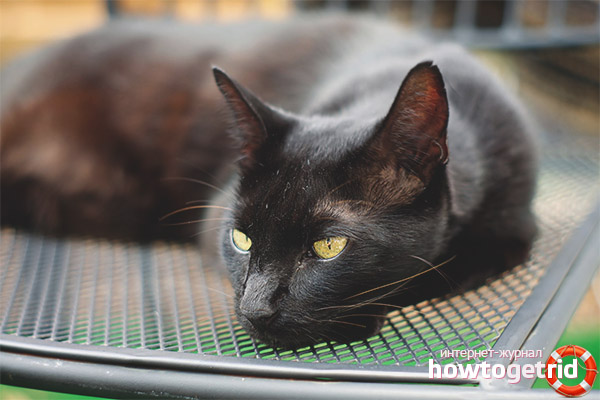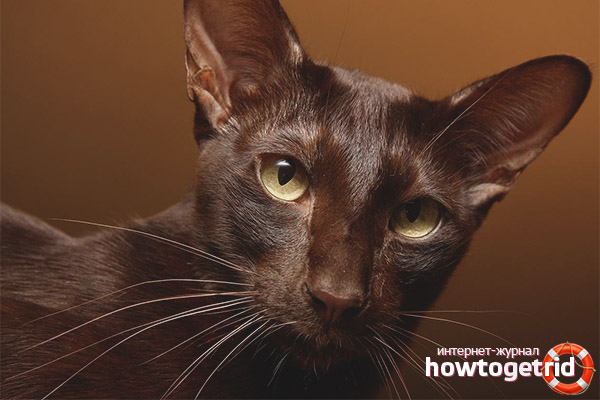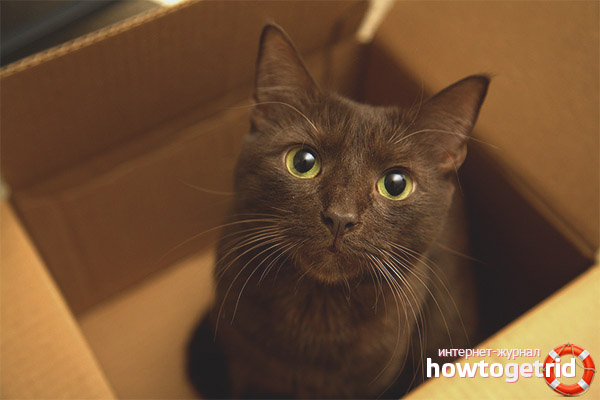The content of the article
Regular Havana is a compact cat in terms of parameters with luxurious hair, monophonic coloring and relief, well-developed musculature. Havana Brown is the result of crossing two breeds - a domestic black and Siamese cat. Attempts to improve the appearance by crossing with Russian blue did not have any success, since geneticists today have not found the latter in the breed of genes.
History
Like most famous breeds, the homeland of Havana Brown is Thailand. The cat left traces of existence and was recorded in the book “The Poem about Cats” and reproduced as sketches on pages between 1350-1767. They have a beautiful solid coat color and clear green-blue eyes. It is believed that it was the color that caused the breed to appear, since the resemblance to the famous cigar is obvious. Information on brown animals was also found in the 1800s, but the British deserved the right to be considered the discoverers of the breed. Crossing chocolate Siamese cats, force point and domestic black shorthair, it was possible to achieve the necessary, amazing effect.
Registration of the breed was recorded in 1958, therefore, England is rightly considered the birthplace of Havana. During this period of time, some of the cats were exported for improvement and breeding in America. Genetics was disrupted by dilution of the English breed by others, and this affected the shade, but the United States managed to maintain its original color. This led to the division into chestnut oriental (different shades of brown) and Havana brown.
Breed standards
Havana Brown is compact in size and visually looks smaller than it actually is. Its maximum weight is about 4 kg, a mature cat with proper maintenance can reach 4.5 kg.
TICA has developed an official standard for this breed, according to which the following indicators should be adhered to:
- Head - in length it is more voluminous than in width. A feature of the breed is a narrowed muzzle and a sharp contrast in the mustache. When viewed from the side of the breed, the foot stands out clearly. A well-developed chin gives a square look to the face of the muzzle. He and his nose visually create a right angle. Adult males may have wider cheeks and cheekbones. Under the lip, a rare coat of wool is natural. The full face is rounded off.
- Ears - large, with rounded edges, located obliquely forward. Their base is cupped, but not prominent. The outer and inner sides are covered with short hair.
- Eyes - Widely spaced, oval. They will acquire true saturation of green color after a year of age, up to this point they tend to change.
- The body is of medium size, in compliance with all proportions, strong and muscular. Females are slightly smaller than males, but harmonious proportions are of particular importance.
- Paws - as for rocks of moderate size, the port has long limbs. In females they are straight, slender, in males the musculature is more developed. Therefore, the legs are more massive, muscular. The hind legs are slightly longer than the front ones, they have four toes, in contrast to the front paws with five.
- Tail - looks harmonious in relation to the body, has a moderate length, not wide at the base and tapers to the tip.
- Wool - can be either short or medium long, with a healthy sheen and smoothness.
- Color - warm shades of brown, the transition to the color of mahogany (brown-red), but not to black and brown, is welcome. The mucous membrane of the nose and the tip itself are brownish pink. Paw pads are pink.
- Mustache correspond to coat color. Residual tabby is permissible only for unripe cats.
The breed is rejected or disqualified if:
- The tail is twisted.
- There is a medallion.
- Finger number mismatch.
- Not a green eye color.
- Mismatch in the color of the nose, mustache, paw pads.
Character Features
Cats do not tolerate loneliness. They constantly require attention and are quite sociable. They get along well with people of any age and animals of other species. The breed for the most part is moderately active; it can, like a dog, catch objects and bring to the owner. He likes to take part in human life, accompanies along the perimeter of the home, trying to choose the highest points for this, as well as a nap next to the owner. An animal is able to attract attention to its person. He climbs to his knees, gently touches the paw pads, flirts. In order to explore the object of their attention, they use not only the organ of smell, but also gently touch their paws.
Havana is hospitable and not afraid of people, moreover, she constantly needs them. If a person is not able to pay due attention to a pet, then it is better to abandon the idea of getting such a cat in the house. Lack of attention on the part of the owner can adversely affect the psycho-emotional state of the animal, leading to depression, spleen, and disease.
Leaving outside the city, you can take a cat with you. Havana is easily and with pleasure able to endure various trips. A new place does not cause stress and resistance.
Cat Health and Disease
At the initial stages of breeding, with a meager selection of genetic material, the breeds were too vulnerable and susceptible to various diseases. Scientific breeding works have made it possible to achieve better health thanks to the expanded gene pool. But something from distant ancestors still survived.
The Siamese have awarded Havana sensitivity to gingivitis, respiratory tract diseases, pathological changes in myocardial structure, and renal impairment syndrome. Havana Brown has an average lifespan of about 15 years.
Care and maintenance features

The breed is short-haired, therefore, does not require constant combing and additional care. Shedding proceeds as usual, but does not differ in abundance of hair loss. In order for the species to be well-groomed and iridescent, it is enough to comb the animal once every 7 days. For these purposes, there is a special rubber comb and suede. You can also use a special mitten to clean the coat.
Periodically, an examination of the ears and trimming of claws on the paws is required. There is no need for frequent bathing.
Interesting historical fact
Thanks to a thorough approach to breeding, the selection of cats was scrupulous. This led to the creation of an ideal, despite too limited gene pool, for all parameters of the breed. In 1974, the cross was stopped by the CFA, as the champion status was obtained too early. Little time has passed in order to make complete conclusions about the breed. The livestock began to decline rapidly, and mating within the genus did not allow the breed to be strong and resistant to disease. The breeders filed a petition at the CFA asking them to allow outcrossing in small quantities.
The main idea was to cross the Havana with chocolate Siamese, Oriental cats and black domestic. CFA made a positive decision and allowed to expand the gene pool - to engage in fruitful improvement of the breed.
Havana Brown offspring
Outwardly, they look disheveled and disproportionate. Toddlers have ruffled hair and large ears. Positive changes occur after 6 months. Kittens acquire the first signs of their breed.
What is the cost of such a kitten? They cannot be cheap because of the small number of clean crosses. Around the world recorded about 100 purebred specimens. The offspring of a pet class, that is, a domestic breed, not perfectly clean, can cost from 900 dollars or about 25 thousand hryvnias. The final cost may depend on the cost of maintaining a cat and kittens.
Where can I get a pet of this breed
If clubs of oriental and Siamese breeds are difficult, but can still be found, then purebred Havana Brown is difficult to buy in the former CIS countries and even in European countries and America. The only available method is private advertisements requiring a detailed check by the breeder and mandatory confirmation of thoroughbredness and health by a veterinary passport.
Video: Havana cat breed











Submit